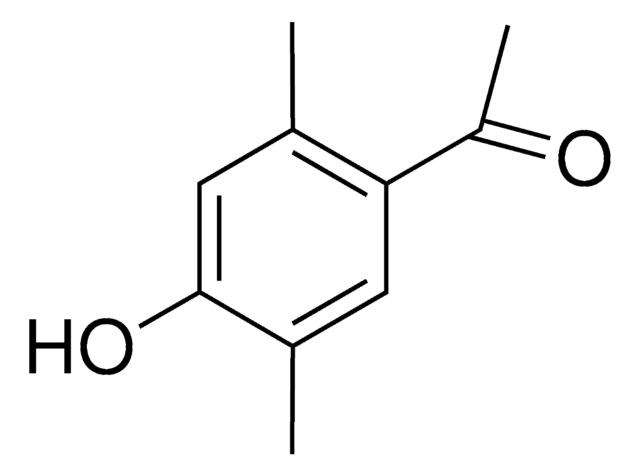Products may be shipped at a different temperature than the recommended long-term storage temperature. If the product quality is sensitive to short-term exposure to conditions other than the recommended long-term storage, it will be shipped on wet or dry-ice. If the product quality is NOT affected by short-term exposure to conditions other than the recommended long-term storage, it will be shipped at ambient temperature. As shipping routes are configured for minimum transit times, shipping at ambient temperature helps control shipping costs for our customers. For more information, please refer to the Storage and Transport Conditions document: https://www.sigmaaldrich.com/deepweb/assets/sigmaaldrich/marketing/global/documents/316/622/storage-transport-conditions-mk.pdf
405655
2-Hydroxy-2-methylpropiophenone
97%
Synonym(s):
1-Hydroxy-1-methylethyl phenyl ketone, 1-Phenyl-2-methyl-2-hydroxypropanone, 2-Hydroxy-2-methyl-1-phenyl-1-propanone, 2-Methyl-3-phenyl-3-oxopropan-2-ol
Select a Size
Select a Size
About This Item
Recommended Products
assay
97%
form
liquid
refractive index
n20/D 1.533 (lit.)
bp
102-103 °C/4 mmHg (lit.)
density
1.077 g/mL at 25 °C (lit.)
SMILES string
CC(C)(O)C(=O)c1ccccc1
InChI
1S/C10H12O2/c1-10(2,12)9(11)8-6-4-3-5-7-8/h3-7,12H,1-2H3
InChI key
XMLYCEVDHLAQEL-UHFFFAOYSA-N
Looking for similar products? Visit Product Comparison Guide
Related Categories
General description
Application
- Photochemical Thiol-Ene “Click” Chemistry: The study utilized 2-hydroxy-2-methylpropiophenone for the synthesis of highly functional polyols by photochemical thiol-ene “click” chemistry (M Ionescu, A Garcia-Comer, T Spidel, 2023).
- Development of Water-Soluble Type I Photoinitiators: This study focused on the development of new water-soluble type I photoinitiators for hydrogel synthesis using 2-hydroxy-2-methylpropiophenone, enhancing the understanding of photopolymerization processes (B Aubry, F Dumur, M Lansalot, E Bourgeat-Lami, 2022).
signalword
Warning
hcodes
Hazard Classifications
Acute Tox. 4 Oral - Aquatic Chronic 3
Storage Class
10 - Combustible liquids
wgk_germany
WGK 1
flash_point_f
251.6 °F - closed cup
flash_point_c
122 °C - closed cup
ppe
Eyeshields, Faceshields, Gloves, type ABEK (EN14387) respirator filter
Choose from one of the most recent versions:
Certificates of Analysis (COA)
Don't see the Right Version?
If you require a particular version, you can look up a specific certificate by the Lot or Batch number.
Already Own This Product?
Find documentation for the products that you have recently purchased in the Document Library.
Customers Also Viewed
-
How is shipping temperature determined? And how is it related to the product storage temperature?
1 answer-
Helpful?
-
-
How can I determine the shelf life / expiration / retest date of this product?
1 answer-
If this product has an expiration or retest date, it will be shown on the Certificate of Analysis (COA, CofA). If there is no retest or expiration date listed on the product's COA, we do not have suitable stability data to determine a shelf life. For these products, the only date on the COA will be the release date; a retest, expiration, or use-by-date will not be displayed.
For all products, we recommend handling per defined conditions as printed in our product literature and website product descriptions. We recommend that products should be routinely inspected by customers to ensure they perform as expected.
For products without retest or expiration dates, our standard warranty of 1 year from the date of shipment is applicable.
For more information, please refer to the Product Dating Information document: https://www.sigmaaldrich.com/deepweb/assets/sigmaaldrich/marketing/global/documents/449/386/product-dating-information-mk.pdfHelpful?
-
Active Filters
Our team of scientists has experience in all areas of research including Life Science, Material Science, Chemical Synthesis, Chromatography, Analytical and many others.
Contact Technical Service









![3-[(2-hydroxy-1-methyl-2-phenylethyl)(methyl)amino]-1-phenyl-1-propanone hydrochloride AldrichCPR](/deepweb/assets/sigmaaldrich/product/structures/151/473/3cebe599-6799-4231-860a-ea27fca60198/640/3cebe599-6799-4231-860a-ea27fca60198.png)





